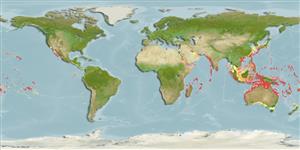Malacostraca |
Stomatopoda |
Gonodactylidae
Environment: milieu / climate zone / Mức độ sâu / distribution range
Sinh thái học
; Mức độ sâu 11 - 62 m (Tài liệu tham khảo 3099). Tropical
Indo-Pacific.
Length at first maturity / Bộ gần gũi / Weight / Age
Chín muồi sinh dục: Lm ? range ? - ? cm Max length : 9 cm TL (female)
Minimum depth from Ref. 80410. Intertidal to subtidal (Ref. 106854). Inhabits sandy bays (Ref. 3533); shallow waters in sand flats, seagrass beds with coral rubble substrate (Ref. 80538) and also in reef flats or tidal flats under rock or boulders or inside rock crevices (Ref. 87055). Stomatopods are predators that require living prey (Ref. 833).
Life cycle and mating behavior
Chín muồi sinh dục | Sự tái sinh sản | Đẻ trứng | Eggs | Sự sinh sản | Larvae
Some members of the order Stomatopoda pair for life and some come together only to mate. Males produce sperm ducts rather than spermatophores; females can brood a maximum of 50,000 eggs. Life cycle: Eggs hatch to a planktonic zoea which lasts for 3 months.
Ahyong, S.T. 2001 Revision of the Australian stomatopod Crustacea. Records of the Australian Museum (Suppl. 26):326 p. (Tài liệu tham khảo 3099)
IUCN Red List Status
(Tài liệu tham khảo 130435: Version 2025-1)
CITES status (Tài liệu tham khảo 108899)
Not Evaluated
CMS (Tài liệu tham khảo 116361)
Not Evaluated
Threat to humans
Harmless
Human uses
| FishSource |
Các công cụ
Thêm thông tin
Sinh thái dinh dưỡngFood items (preys)
Thành phần thức ăn
Thành phần thức ăn
Các động vật ăn mồi
Population dynamicsSự sinh trưởngMax. ages / sizesLength-weight rel.Length-length rel.Length-frequenciesMass conversionSự phong phú Life cycleSự tái sinh sảnChín muồi sinh dụcSự sinh sảnĐẻ trứngEggsEgg developmentLarvae PhysiologyThành phần ô-xy
Human RelatedStamps, coins, misc.
Các nguồn internet
Estimates based on models
Preferred temperature
(Ref.
115969): 24.3 - 29, mean 27.8 (based on 912 cells).
Fishing Vulnerability
Low vulnerability (10 of 100).
